Momentum Slowing
By Colin Twiggs
January 13, 2006 12.00 a.m. ET (4:00 p.m. AET)
These extracts from my daily trading diary are for educational purposes and should not be interpreted as investment advice. Full terms and conditions can be found at Terms of Use.
USA: Dow, Nasdaq and S&P500
The Dow Jones Industrial Average is approaching its
target of 12500 (11600+[11600-10700]). Momentum has slowed,
with the index dipping below the lower border of its trend
channel (drawn at 2 standard deviations around a linear
regression line) and the bearish
divergence on
Twiggs Money Flow (21-day) warns that the index may be
nearing a secondary correction.
The primary trend is up with support at 11600/11650 (preceding
high) and 10700 (preceding low).
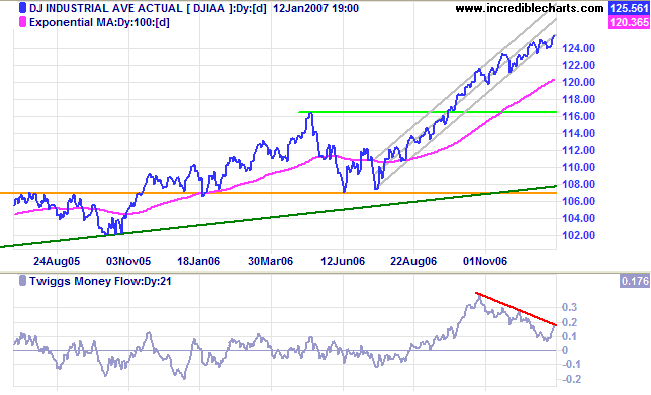
Short Term: A close below support at 12350 would be a further bear signal.
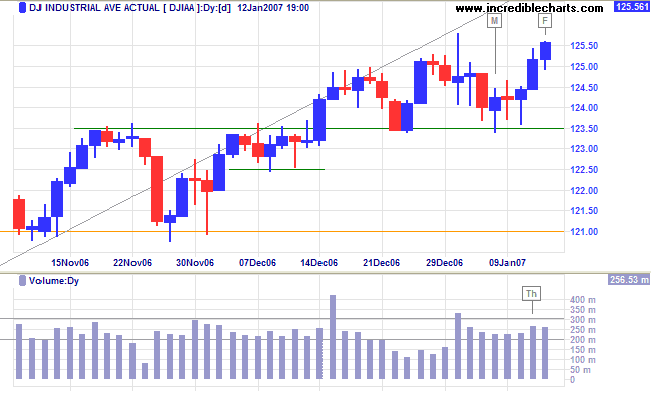
The Dow Jones Transportation Average retraced below intermediate support at 4600, but has since recovered and now appears headed for another test of resistance at 5000. This time the index faces two levels of resistance: intermediate at 4900 and primary at 5000. Breakout above 5000 would confirm the existence of a bull market.
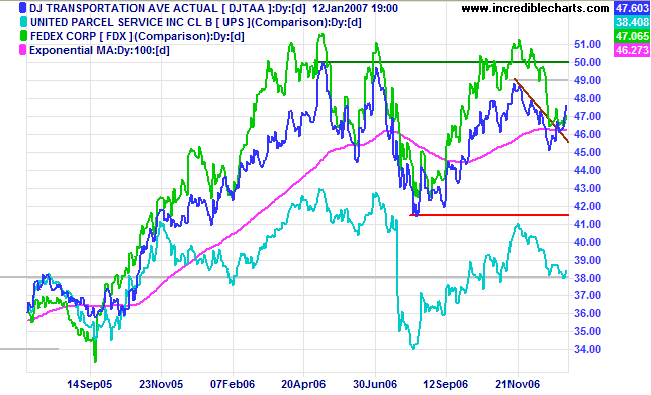
The Nasdaq Composite shows good trend strength, having
broken out above the consolidation between 2400 and 2450/2470.
Twiggs Money Flow appears to be recovering, having broken
the downward trendline and respecting zero.
The index remains in a primary up-trend with support at
2350/2370 (preceding high) and at 2000 (preceding low).
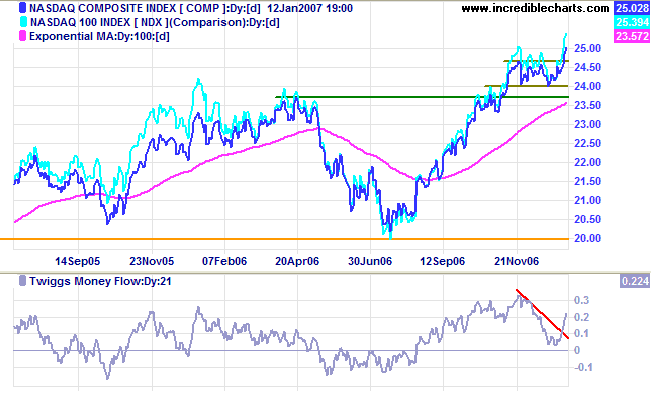
The S&P 500 closely resembles the Dow, with momentum slowing as it approaches its target of 1430 (1325+[1325-1220]) and a bearish divergence on Twiggs Money Flow (21-day), warning of a secondary correction (or consolidation). A reversal would be likely to test the lower border of the standard deviation channel.
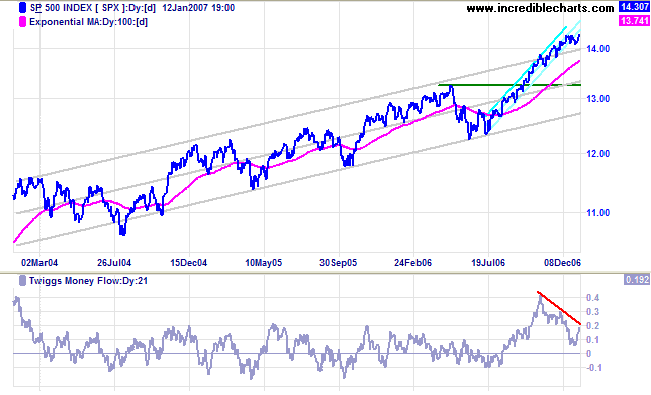
LSE: United Kingdom
The FTSE 100 consolidating between 6000 and 6250/6300
signals uncertainty. A breakout above 6300 would signal
continuation of the up-trend, while a fall below 6000 (breaking
the 100-day moving
average and the long-term trendline) would warn of a test
of primary support at 5500 and a possible stage 3 top. The
bearish
divergence on
Twiggs Money Flow (21-day) warns of some
distribution.
Long Term: The primary up-trend continues, with support
at 6000/6100 (preceding high) and at 5500 (preceding low).
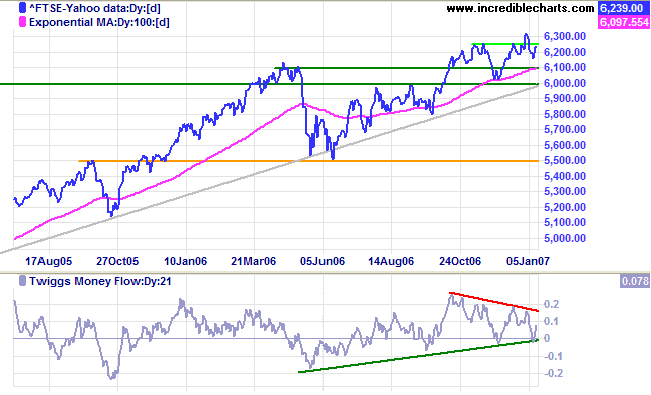
Nikkei: Japan
The Nikkei 225 is making a reasonable recovery, with
Twiggs Money Flow (21-day) signaling accumulation above the
zero line. Expect a test of resistance at the April 2006 high
of 17500.
Long Term: The index continues in an up-trend with
primary support at 14200 (preceding low) and resistance at
17500 (preceding high). A break above 17500 would be a strong
bull signal.
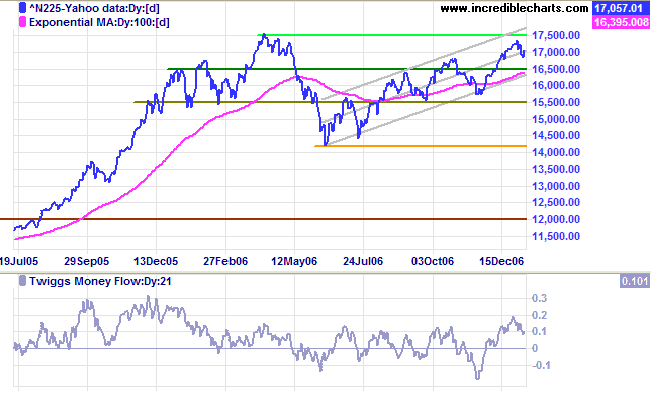
ASX: Australia
The All Ordinaries is some way from its target of 5800
(5300+[5300-4800]), but a strong bearish divergence on
Twiggs Money Flow (21-day) warns of a secondary correction
or large consolidation.
Long Term: The primary trend is upwards, with support at
5300 (the preceding high) and 4800 (preceding low).
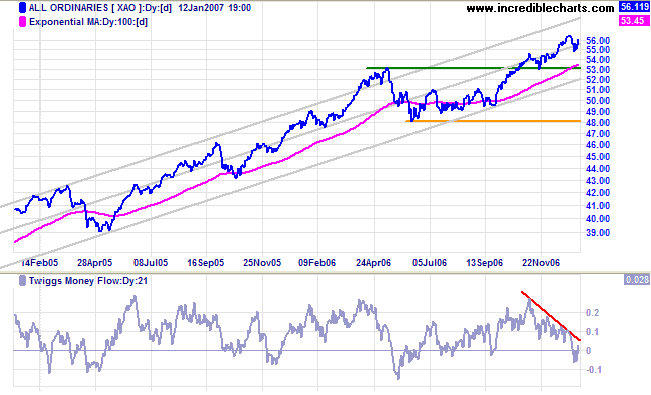
Short Term: A rise above the recent high of 5650 would signal continuation of the up-trend, while a fall below Monday's low [M] of 5480 would warn of a secondary correction.
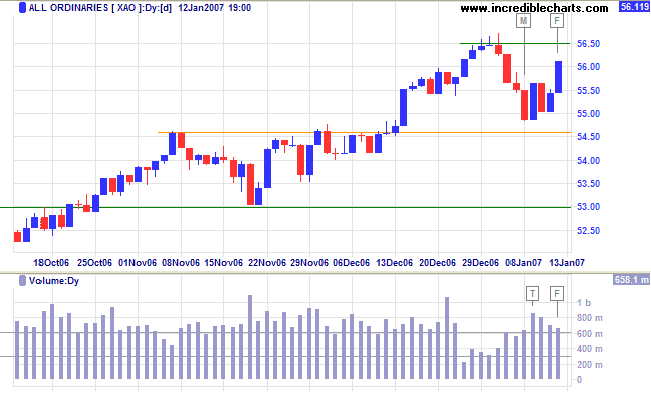
It is a rare qualification to be ale to state a fact simply and
adequately.
To digest some experience cleanly.
To say yes and no with authority--To make a square edge.
To conceive and suffer the truth to pass through us living and
intact....
Say it and have done with it. Express it without expressing
ourself.
~ Henry David Thoreau (1851)
|
Technical Analysis and Predictions I believe that Technical Analysis should not be used to make predictions because we never know the outcome of a particular pattern or series of events with 100 per cent certainty. The best that we can hope to achieve is a probability of around 80 per cent for any particular outcome: something unexpected will occur at least one in five times. My approach is to assign probabilities to each possible outcome. Assigning actual percentages would imply a degree of precision which, most of the time, is unachievable. Terms used are more general: "this is a strong signal"; "this is likely"; "expect this to follow"; "this is less likely to occur"; "this is unlikely"; and so on. Bear in mind that there are times, especially when the market is in equilibrium, when we may face several scenarios with fairly even probabilities. Analysis is also separated into three time frames: short, medium and long-term. While one time frame may be clear, another could be uncertain. Obviously, we have the greatest chance of success when all three time frames are clear. The market is a dynamic system. I often compare trading to a military operation, not because of its' oppositional nature, but because of the complexity, the continual uncertainty created by conflicting intelligence and the element of chance that can disrupt even the best made plans. Prepare thoroughly, but allow for the unexpected. The formula is simple: trade when probabilities are in your favor; apply proper risk (money) management; and you will succeed. For further background, please read About The Trading Diary. |

Author: Colin Twiggs is a former investment banker with almost 40 years of experience in financial markets. He co-founded Incredible Charts and writes the popular Trading Diary and Patient Investor newsletters.
Using a top-down approach, Colin identifies key macro trends in the global economy before evaluating selected opportunities using a combination of fundamental and technical analysis.
Focusing on interest rates and financial market liquidity as primary drivers of the economic cycle, he warned of the 2008/2009 and 2020 bear markets well ahead of actual events.
He founded PVT Capital (AFSL No. 546090) in May 2023, which offers investment strategy and advice to wholesale clients.
